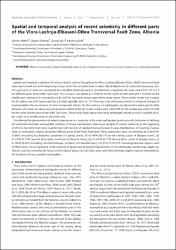Spatial and temporal analysis of recent seismicity in different parts of the Vlora-Lushnja-Elbasani-Dibra Transversal Fault Zone, Albania

Göster/
Erişim
info:eu-repo/semantics/openAccessTarih
2017Erişim
info:eu-repo/semantics/openAccessÜst veri
Tüm öğe kaydını gösterÖzet
Spatial and temporal evaluation of current seismic activity throughout the Vlora-Lushnja-Elbasani-Dibra (VLED) transversal fault zone were carried out at the beginning of year 2016. The seismotectonic b-value, fractal dimension Dc-value and precursory seismic quiescence Z-value are considered for a detailed statistical analysis. Completeness magnitude Mc-value varies from 2.5 to 2.7 for different parts of the VLED fault zone. The b-value is calculated as 1.10 +/- 0.04 for the south western part and 1.13 +/- 0.05 for the middle part, whereas it is estimated as 0.94 +/- 0.07 for the north eastern part of the study region. These results reveal that b-values for all regions are well represented by a b-value typically close to 1.0. There are clear decreasing trends in temporal changes of b-values before the occurrences of some strong main shocks. On the contrary, no earthquakes are observed in some periods after decrease of b-value. Dc-values are computed as 2.66 +/- 0.04 for the south western part, 2.64 +/- 0.03 for the middle part and 2.15 +/- 0.02 for the north eastern part of the VLED fault zone. These rather large values show that earthquake activity is more clustered at larger scales or in smaller areas in the study area. Considering the phenomenon of seismic quiescence as a precursor of the main earthquakes gives successful outcomes in defining the potential anomalies and possible locations of future earthquakes. Quiescence analysis of current seismicity at the beginning of 2016 in the VLED fault zone is performed with the test of standard normal deviate Z-value. Distributions of resulting Z-values show six anomalous regions along the different parts of the VLED fault zone. These quiescence areas are detected at (i) 40.81 degrees N-19.86 degrees E (including Kuc-Bubullim, southeast of Lushnja town), (ii) 41.00 degrees N-20.01 degrees E (in the Cerriku, south of Elbasani town), (iii) 41.31 degrees N-20.13 degrees E (around Bene-Qafe, northeast of Elbasani town), (iv) 41.43 degrees N-20.21 degrees E (Krasta-Batra, south of Bulqiza town), (v) 41.28 degrees N-20.49 degrees E (including Carrishta-Stebleve, northeast of Librazhdi town), (vi) 41.51 degrees N-20.51 degrees E (including Qerrenec-Gjorica, west of Dibra town). As an important result, analyses of spatial and temporal characteristics of the earthquake activity may supply significant clues for revealing the future seismic hazard along the VLED fault zone, and these anomaly regions may be interpreted as the locations of next possible earthquakes.

















